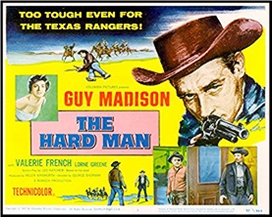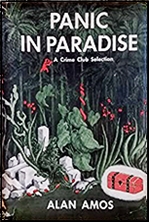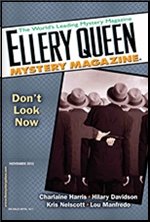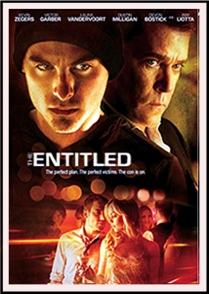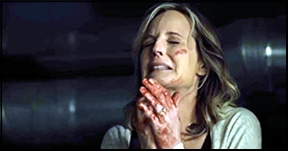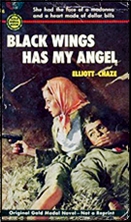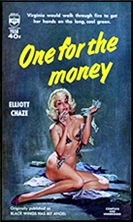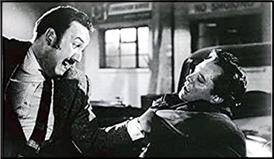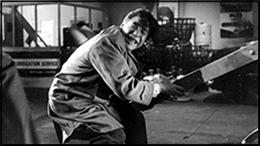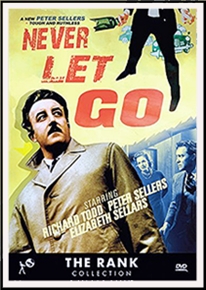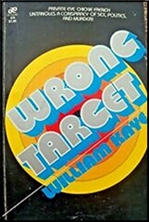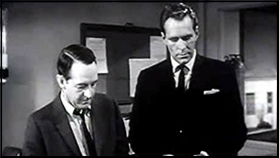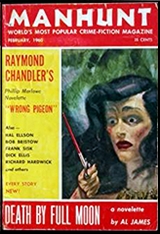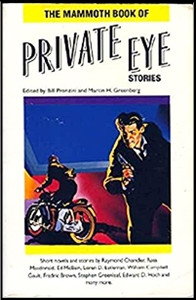Fri 17 Apr 2020
A Western Movie Review by Jonathan Lewis: THE HARD MAN (1957).
Posted by Steve under Reviews , Western movies[3] Comments
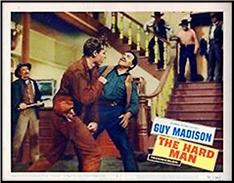
THE HARD MAN. Columbia Pictures, 1957. Guy Madison, Valerie French, Lorne Greene, Barry Atwater, Robert Burton, Rudy Bond, Trevor Bardette, Myron Healey. Director: George Sherman.
The Hard Man begins with a gunfight. Lawman Steve Burden (Guy Madison) faces off against his friend, Ray Hendry (Myron Healey). Hendry is quick with his gun. But not quick enough. For Burden ends up killing Ray. So much for questioning him. As it turns out, there was some question as to whether Ray was truly guilty of murder or whether he had been set up. To find out, Burden travels to a small town where cattle baron Rice Martin (Lorne Greene) and his wife live out a tenuous romantic existence. Martin’s top dog in town and he’s sure to let everyone know it. But being a big shot doesn’t mean that his wife Fern (Valerie French) is beyond straying. In fact, nothing seems to set Martin into more of a rage than knowing his wife may be running around behind his back.
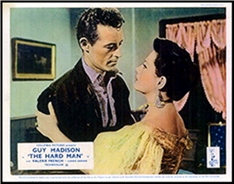
Although the movie is most definitely a Western, there’s something very film noir about the whole affair. A movie nominally about a tough lawman, it really turns out to center around a femme fatale and her ability to skillfully manipulate the men in her life. Fern Martin plays all the menfolk against each other, weaving a devious little web of lies as the body count piles up. In tandem with the film noir plot, the movie also has numerous instances where some exceptionally hardboiled dialogue is employed. These scenes are thoroughly enjoyable, such as when Rice asks his wife why she sits in the dark like a cat, and she answers that it allows her to avoid seeing things she’s rather not see. Good stuff, indeed.
Now, is The Hard Man a particularly good movie? Yes and no. It’s got some grating orchestral music for a score, and it has a decidedly studio lot feel to it. No wide vistas here. And Guy Madison, while talented, simply didn’t have the screen charisma of John Wayne, Randolph Scott, or James Stewart.
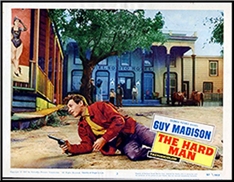
And yet. If you go into The Hard Man expecting very little, you might find yourself pleasantly surprised. While an overall decidedly average motion picture, this Columbia Pictures release has several things going for it. Although Madison was the top-billed star, it’s really Lorne Greene and Rudy Bond who shine. Both basically steal every scene they are in. Many will primarily remember Greene as America’s favorite TV dad Ben Cartwright on Bonanza or as Adama on the original Battlestar Galactica. In The Hard Man, Greene gets to demonstrate his ability to play a villain with great skill. His physicality, combined with his distinct deep voice, makes for a thundering bravado performance.
As for Rudy Bond, his portrayal of a hired gunslinger is utterly convincing and delightfully memorable. Bond also demonstrated similar traits in his portrayal of a murderous bank robber in Jacques Tourneur’s Nightfall (1957), released that same year. Rudy Bond double feature? Sounds good to me.
